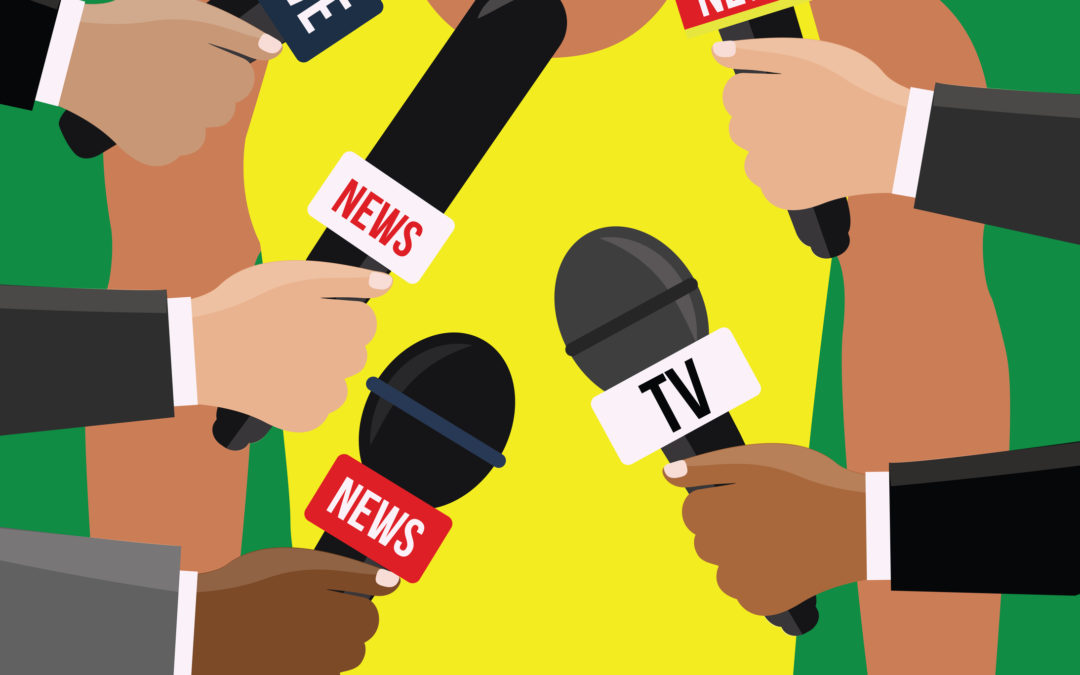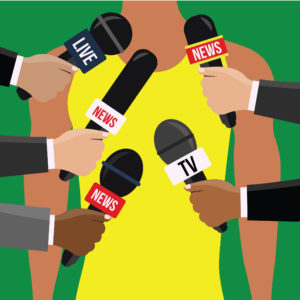
by Beth Levine | Mar 20, 2018 | preparing for a presentation, public speaking
I often wax on about audiences and audience-centricity: that you need to put your audience’s needs and interests ahead of your own, that it’s all about them, that they need tons of “guidance” in order to be able follow your presentation and get the point. All true. Perhaps never truer, as audiences have hand-held alternatives for their fickle feed-me-now attention spans.
 Guidance has always been a big one for me. Tell your audiences where you’re taking them, what you expect of them or want them to have at the end, when you’re digressing for a story, when you’re on main point #1, #2 or #3, and when you’re concluding. Don’t be afraid to speak your presentation structure out loud, so when an audience member’s attention drifts away, they’ll be able to track where you are when they bring their attention back to you.
Guidance has always been a big one for me. Tell your audiences where you’re taking them, what you expect of them or want them to have at the end, when you’re digressing for a story, when you’re on main point #1, #2 or #3, and when you’re concluding. Don’t be afraid to speak your presentation structure out loud, so when an audience member’s attention drifts away, they’ll be able to track where you are when they bring their attention back to you.
Two weeks ago, I was lucky enough to attend an executive speechwriting conference in Washington, D.C. Given the location, a lot of the speakers were from government and politics, but corporate America, higher education and healthcare were also nicely represented. There was a great cross-section of perspectives, experiences and standards shared by speakers and attendees alike. Friends and colleagues who knew I was going to the conference asked if I was speaking or attending. When I replied that I was attending and really excited to go and learn, I got some raised eyebrows.
Well, learn I did! I’ll admit it was gratifying when many of my methods and principles were validated by what I heard. But I’ll also readily admit that I took copious notes and brought back all kinds of new ideas.
Among those was “verbal wayfinding.” Verbal wayfinding is the more sophisticated term for guidance and is, in my view, a more well-developed concept. The other terms used interchangeably with verbal wayfinding were “breadcrumbs” and “signposts” – more than guidance, these refer to weaving into a speech or presentation thematic reminders and reinforcements as well as the structural ones that my word guidance encourages.
The bottom line is this: Your audiences have not seen your notes or read your script, nor have they rehearsed with you. They are fresh-earred, first-time listeners, and they will only hear it that one time. You and your material have shared countless moments together, but your audiences will share only one moment. It’s your job to make that moment count, make the material stick. Drop breadcrumbs throughout, put up signposts, script in verbal wayfinding, because it’s all about them, your audience, and they need guidance!

by Beth Levine | Mar 5, 2018 | public speaking
 All too often, in preparation for a speech or presentation, we focus on words and content, believing very sincerely in their importance. And I must confess, I am quite possibly more guilty of this than most.
All too often, in preparation for a speech or presentation, we focus on words and content, believing very sincerely in their importance. And I must confess, I am quite possibly more guilty of this than most.
So, in an effort to self-correct – and provide readers with valuable, necessary insights – I want to share some interesting facts about the importance of non-verbal communication:
-
Human communication is approximately 20% verbal and 80% non-verbal. This means if you’re saying something but your body language says the opposite, you’re not likely to get your message across. The focus on words and content is therefore lost.
-
According to researchers, our bodies express emotion better than our faces. Body language matters. It speaks volumes about us to others.
-
The average person actually only speaks words for a total of 10-11 minutes a day. And the average sentence takes 2.5 seconds to say. This, of course, is not the case for someone delivering a speech or presentation but is interesting to note in terms of other everyday communications.
-
We make and recognize about 25,000 facial expressions a day. Wow, that’s a lot of subtle, subconscious two-way communication.
-
Pointing is one of the most offensive gestures – and this is true pretty much around the globe.
-
Hand-steepling is one of the most high-confidence hand gestures. In general, hand and body gestures that move in an upward or out (toward your audience) direction register as positive.
-
Power poses – e.g. standing up, sitting with arms spread out on the on the chairs around you, “Wonder Woman” stance (feet planted; hands on hips) – make speakers feel more powerful as they actually change testosterone and cortisol levels in the body.
These are important insights to keep in mind, but you still need to be authentically you when you’re speaking in front of a group. We all have our own personal styles and preferences. Mine include moving around the room (as long as I don’t have a fixed podium mic), lots of eye contact, and gesturing out toward the audience. I smile a lot in one-on-one personal conversation, but I find that I have to make an effort to remember to smile when I speak publicly (go figure!).
Think about what your style and preferences are, and then identify one or two body language elements you might need or want to add. Try them, and good luck out there!

by Beth Levine | Feb 20, 2018 | preparing for a presentation, public speaking
“I want to go over to the judges and say, ‘Can I just have a Xanax and a quick drink?’” – Adam Rippon, U.S. Olympic Figure Skater.

What do you think of these quotes? Funny? Edgy? Whiny? Inappropriate? Authentic?
Are they simply sharing, self-revealing and being incredibly transparent?
Don’t get me wrong here. I, too, ADORE and IDOLIZE these two athletes. They both were amazing to watch, delivered incredible athletic performances and charmed the pants off of me and the rest of America in their interviews.
 However, I’m also a little old school about the Olympic Games and Olympic Athletes. While I encourage transparency and authenticity among my athlete and executive coachees, I believe the Olympics – more than any other sporting competition – call for a special kind of decorum. Athletes on the U.S. Olympic Team are not competing for a privately owned franchise, like an NBA or NFL team. These athletes are competing for the red, white and blue of the United States of America. The “brand” they represent is a complex mix of themselves, their sport/team and their country (not to mention, their sponsors, coaches and families). It’s a high bar to represent all of those entities well, but that’s what the Olympic Games demand.
However, I’m also a little old school about the Olympic Games and Olympic Athletes. While I encourage transparency and authenticity among my athlete and executive coachees, I believe the Olympics – more than any other sporting competition – call for a special kind of decorum. Athletes on the U.S. Olympic Team are not competing for a privately owned franchise, like an NBA or NFL team. These athletes are competing for the red, white and blue of the United States of America. The “brand” they represent is a complex mix of themselves, their sport/team and their country (not to mention, their sponsors, coaches and families). It’s a high bar to represent all of those entities well, but that’s what the Olympic Games demand.
For our part, the hero-worship is real and while we do want to know (and I do want them to share) what’s going on in their heads, especially prior to competition, I would prefer a little more careful selection in the words they choose. Little kids are watching, listening, modeling.
Having said that, I do recognize that both of these athletes meant to be self-effacing in these quotes versus the much-less-tolerable self-aggrandizing, and I applaud them for that. It’s also noteworthy that both of these quotes got a lot of positive attention. And in an almost immediate endorsement of his widespread appeal, Adam Rippon was offered a commentator position by NBC for the duration of the Games as soon as he finished competing. So there’s that too.
Perhaps I need to make an adjustment to my old-school thinking? Is there such a thing as “proper jock talk” for the Games? Let me know your opinion, I’m eager to hear what others think. I have until Summer of 2020 in Tokyo to change my outlook if necessary!
#jocktalkbook

by Beth Levine | Feb 6, 2018 | preparing for a presentation, public speaking
To Team USA:
 Congratulations! You have achieved your dream, you are in PyeongChang now, and the Opening Ceremony is in two days. You are among the very best in your sport and you are so ready for the Olympic Games to begin.
Congratulations! You have achieved your dream, you are in PyeongChang now, and the Opening Ceremony is in two days. You are among the very best in your sport and you are so ready for the Olympic Games to begin.
But … are you ready for the Image Games?
Here are 5 points to remind you – and anyone who cares about their brand and reputation – how to view and play the media game:
1. Reporters have a job to do. They need to tell a story and include quotes to support the story. Without quotes, it would be an opinion piece. Sure, they get it wrong or twist things sometimes (usually unintentional) but, like you do with competition, stay focused and do your best to influence the outcome.
2. Play offense, not defense. Have an offensive strategy. Know how you like to talk about yourself, your sport, the competition, winning/placing/losing. Don’t play defense and simply wait for the questions to come at you only to have to think and respond on the fly. In other words, be prepared for what you know are the “usual suspect” questions.
3. Be gracious. About everything and everyone. At all times. Take the high road. Anything less sounds like sour grapes, sore winning/losing, or just plain ungrateful. Even if there’s a competitor that you and everyone else would like to pounce on, resist. On a world stage, in the spirit of sport and peace, give everyone the benefit of the doubt and stick to what you know best – yourself and your own performance. In the end, throwing shade on others casts more doubt on you than it does on them.
4. Be transparent. Be real. You are likely to be extremely real on social media, so be consistent when you talk to the traditional print and broadcast media. It’s okay to be vulnerable, emotional, frustrated or upset. Just own it and be gracious about it. Even crying is okay, everyone can empathize. The more real you are, the more accessible you are; the more accessible you are, the more your appealing you and your image are.
5. Maintain perspective. Everyone, spectators and reporters alike, would give anything to be in your shoes (or skis, skates, luge, bobsled) even for only 2 minutes. You, during these 16 days, are the darlings and envy of your country and the world. Reporters, because they get to be so close to you and the “field of play” for these 16 days, are especially prone to fandom. They’re there to be an insider as much as anything else, so keep that in mind. The only people looking to take you down are your competitors. Everyone else is pulling for you, even the media.
It’s hard enough to do a good job – in your case, deliver a world-class performance and make your families and country proud – when you compete. But then, moments later, when you’re confronted with a microphone and camera, the job continues. Hopefully these 5 points will help you wrap your head around delivering a medal-winning performance in the Image Games too. Go Team USA, we’re rooting for you!
by Beth Levine | Jan 22, 2018 | preparing for a presentation, public speaking
 Bloviate is a verb, usually attributed to the oral meanderings of politicians. It’s one of those words that sounds a lot like what it is – to blow hot air – or, according to the Oxford Dictionary, “to talk at length, especially in an inflated or empty way.” To blow hot air indeed.
Bloviate is a verb, usually attributed to the oral meanderings of politicians. It’s one of those words that sounds a lot like what it is – to blow hot air – or, according to the Oxford Dictionary, “to talk at length, especially in an inflated or empty way.” To blow hot air indeed.
Unfortunately, bloviating is not limited to the chambers of government. It happens in conference rooms and board rooms too. In fact, in some organizations, the bloviators are well known and their long-winded command of nothing is expected and – all too often – accepted as inevitable.
Well, in the interest of efficiency and effectiveness, I’m calling out those who bloviate and those who enable them. It’s time to stop – if not in the interest of efficiency (time) and effectiveness (getting things done), then in the interest of your audiences because their time and attention are precious commodities. Audiences may be clients, employees, partners, suppliers, regulators, stakeholders, or simply colleagues. No matter who they are, I’m willing to bet that not one of them appreciates, enjoys, learns from, or is impressed by a bloviator.
Following are a few of the ways in which people bloviate in meetings and what to do about it.
The floor hog. Yes, that one person who seems to love the sound of their own voice. Once they get the floor, it’s hard to wrestle it away from them.
The fabricator. This is the person who doesn’t know the answer to a question but keeps talking (and, to those more in the know, keeps digging the hole deeper).
The know-it-all. Smartest-person-in-the-room syndrome somehow never afflicts the person who is, in fact, the smartest person in the room. It’s usually someone who, for whatever reason, feels the need to puff themselves up.
The empty suit. This person may look the part but doesn’t know what they’re doing … or saying. And they don’t have the self-awareness or good graces to keep quiet.
Do these bloviating types sound familiar? I bet they do. And I bet your eyes rolled back in your head at least once. The fix is tough, though, because the common thread among these types is that they’re not audience-centric and therefore not good listeners or well-attuned to social cues (an understatement perhaps).
Given these limitations, neither being subtle nor confronting them as a means of correcting the behavior are likely to be very successful. It is therefore best to use behavior modification tactics. For example, try some of these:
- set and enforce strict meeting agendas with pre-assigned participants and pre-assigned allotments of time for each;
- select or assign a senior person to be the official interruptor of your bloviating colleague;
- if you can (i.e. in internal or informal meetings), call an abrupt end to the meeting once the hot air begins to blow; or
- if possible, stop inviting them to meetings.
Once it starts to affect their career opportunities and prospects, the bloviator might well sit up and take notice. Until then, it’s up to others to find ways to send the message not with the use of hot air but by taking action.

 Guidance has always been a big one for me. Tell your audiences where you’re taking them, what you expect of them or want them to have at the end, when you’re digressing for a story, when you’re on main point #1, #2 or #3, and when you’re concluding. Don’t be afraid to speak your presentation structure out loud, so when an audience member’s attention drifts away, they’ll be able to track where you are when they bring their attention back to you.
Guidance has always been a big one for me. Tell your audiences where you’re taking them, what you expect of them or want them to have at the end, when you’re digressing for a story, when you’re on main point #1, #2 or #3, and when you’re concluding. Don’t be afraid to speak your presentation structure out loud, so when an audience member’s attention drifts away, they’ll be able to track where you are when they bring their attention back to you.

 All too often, in preparation for a speech or presentation, we focus on words and content, believing very sincerely in their importance. And I must confess, I am quite possibly more guilty of this than most.
All too often, in preparation for a speech or presentation, we focus on words and content, believing very sincerely in their importance. And I must confess, I am quite possibly more guilty of this than most.

 However, I’m also a little old school about the Olympic Games and Olympic Athletes. While I encourage transparency and authenticity among my athlete and executive coachees, I believe the Olympics – more than any other sporting competition – call for a special kind of decorum. Athletes on the U.S. Olympic Team are not competing for a privately owned franchise, like an NBA or NFL team. These athletes are competing for the red, white and blue of the United States of America. The “brand” they represent is a complex mix of themselves, their sport/team and their country (not to mention, their sponsors, coaches and families). It’s a high bar to represent all of those entities well, but that’s what the Olympic Games demand.
However, I’m also a little old school about the Olympic Games and Olympic Athletes. While I encourage transparency and authenticity among my athlete and executive coachees, I believe the Olympics – more than any other sporting competition – call for a special kind of decorum. Athletes on the U.S. Olympic Team are not competing for a privately owned franchise, like an NBA or NFL team. These athletes are competing for the red, white and blue of the United States of America. The “brand” they represent is a complex mix of themselves, their sport/team and their country (not to mention, their sponsors, coaches and families). It’s a high bar to represent all of those entities well, but that’s what the Olympic Games demand.
 Congratulations! You have achieved your dream, you are in PyeongChang now, and the Opening Ceremony is in two days. You are among the very best in your sport and you are so ready for the Olympic Games to begin.
Congratulations! You have achieved your dream, you are in PyeongChang now, and the Opening Ceremony is in two days. You are among the very best in your sport and you are so ready for the Olympic Games to begin. Bloviate is a verb, usually attributed to the oral meanderings of politicians. It’s one of those words that sounds a lot like what it is – to blow hot air – or, according to the Oxford Dictionary, “to talk at length, especially in an inflated or empty way.” To blow hot air indeed.
Bloviate is a verb, usually attributed to the oral meanderings of politicians. It’s one of those words that sounds a lot like what it is – to blow hot air – or, according to the Oxford Dictionary, “to talk at length, especially in an inflated or empty way.” To blow hot air indeed.

